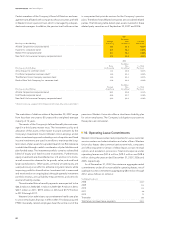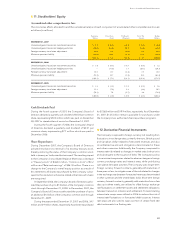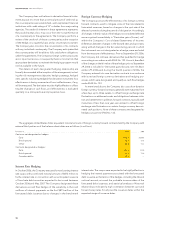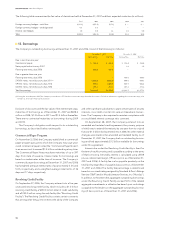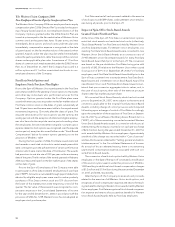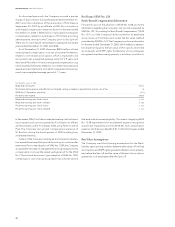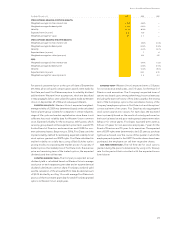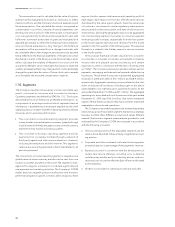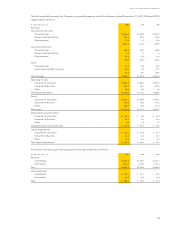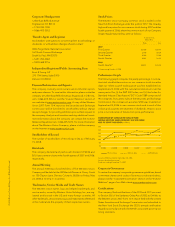Western Union 2007 Annual Report Download - page 80
Download and view the complete annual report
Please find page 80 of the 2007 Western Union annual report below. You can navigate through the pages in the report by either clicking on the pages listed below, or by using the keyword search tool below to find specific information within the annual report.78
WESTERN UNION 2007 Annual Report
The assumptions used to calculate the fair value of options
granted will be evaluated and revised, as necessary, to refl ect
market conditions and the Company’s historical experience and
future expectations. The calculated fair value is recognized as
compensation cost in the Company’s fi nancial statements over
the requisite service period of the entire award. Compensation
cost is recognized only for those options expected to vest, with
forfeitures estimated at the date of grant and evaluated and
adjusted periodically to refl ect the Company’s historical experi-
ence and future expectations. Any change in the forfeiture
assumption will be accounted for as a change in estimate, with
the cumulative effect of the change on periods previously reported
being refl ected in the fi nancial statements of the period in which
the change is made. In the future, as more historical data is avail-
able to calculate the volatility of Western Union stock and the
actual terms Western Union employees hold options, expected
volatility and expected term may change which could substantially
change the grant-date fair value of future stock option awards
and, ultimately, the recorded compensation expense.
||
15. Segments
The Company classifi es its businesses into two reportable seg-
ments: consumer-to-consumer and consumer-to-business.
Operating segments are defi ned by SFAS No. 131, “Disclosures
About Segments of an Enterprise and Related Information,” as
components of an enterprise about which separate fi nancial
information is available that is evaluated regularly by the chief
operating decision maker (“CODM”) in deciding where to allocate
resources and in assessing performance.
||
The consumer-to-consumer reporting segment provides
money transfer services between consumers, primarily through
a global network of third-party agents using our multi-currency,
real-time money transfer processing systems.
|| The consumer-to-business reporting segment provides
payments from consumers to billers through a network of
third-party agents and other various electronic channels,
including the telephone and the internet. The segment’s
revenue was primarily generated in the United States for all
periods presented.
The consumer-to-consumer reporting segment is viewed as one
global network where a money transfer can be sent from one
location to another, anywhere in the world. The segment is man-
aged as four regions, primarily to coordinate agent network
management and marketing activities. The Company’s CODM
makes decisions regarding resource allocation and monitors
performance based on specifi c corridors within and across these
regions, but also reviews total revenue and operating profi t of
each region. Each region and corridor offer the same services
distributed by the same agent network, have the same types
of customers, are subject to similar regulatory requirements,
are processed on the same system, and have similar economic
characteristics, allowing the geographic regions to be aggregated
into one reporting segment. Consumer-to-consumer segment
revenue typically increases sequentially from the fi rst quarter
to the fourth quarter each year and declines from the fourth
quarter to the fi rst quarter of the following year. This seasonal
fl uctuation is related to the holiday season in various countries
in the fourth quarter.
All businesses that have not been classifi ed into consumer-
to-consumer or consumer-to-business, primarily the Company’s
money order and prepaid services businesses, and certain
expenses incurred in connection with the Spin-off are reported
as “Other.” The Company previously operated internet auction
payments, messaging and international prepaid cellular top-up
businesses. These three businesses represented aggregated
revenues in 2006 and 2005 of $4.1 million and $28.9 million,
respectively. Aggregate operating income related to the shut
down or disposed of businesses, including a gain on the sale of
assets related to our internet auction payments business, for the
year ended December 31, 2006 was $0.1 million. The aggregate
operating loss associated with such businesses in the year ended
December 31, 2005 was $(16.2) million. Due to the immaterial
nature of these three businesses, they have not been presented
separately as discontinued operations.
The Company’s reportable segments are reviewed separately
below because each reportable segment represents a strategic
business unit that offers different products and serves different
markets. The business segment measurements provided to, and
evaluated by, the Company’s CODM are computed in accordance
with the following principles:
|| The accounting policies of the reportable segments are the
same as those described in the summary of signifi cant account-
ing policies.
|| Corporate and other overhead is allocated to the segments
primarily based on a percentage of the segments’ revenue.
||
Expenses incurred in connection with the development of
certain new service offerings, including costs to develop
mobile money transfer and micro-lending services, and non-
recurring costs incurred to effect the Spin-off are not allocated
to the segments.
|| All items not included in operating income are excluded.


